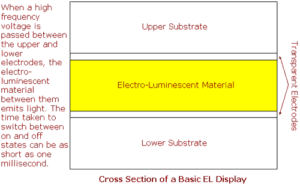Elegant in their simiplicity, electro-luminescent displays offer the thinnest profile of any colour flat panel technology.
The principle of EL displays is very simple. In construction they consist of an upper and lower substrate and upper and lower electrodes sandwiching a material which will give off light when high frequency voltage is applied. The whole assembly can be as little as two millimetres in depth, is very light, can switch states in about a millisecond, requires very little power has a wide viewing angle and can be quite rugged.
Like a number of the technologies being used to develop modern displays, the principle of EL has been known for a long time, in this case since 1936. Initially, EL was seen as a possible replacement for the incandescent lamp but the technology required to produce sufficient light output did not exist until relatively recently. It wasn’t until the 1980’s that the first commercial use was made of EL, when the technology was used to create illuminated displays in cars. As more efficient EL became possible it started to be used as an illumination source in clocks and watches and for displays in mobile phones. All the early EL devices were monochrome, with a limited range of fairly impure colours being available. Attempts were made to produce full-colour displays, using white-emitting EL materials with coloured filters, but met with little success as the filters cut the efficiency of the displays to an unacceptable level. During the 1990s, however, EL materials producing purer colours were developed and the prospect of full-colour EL displays became a possibility.
Today colour graphic EL displays are used in medical instruments and other industrial applications where their high contrast and wide viewing angles provide excellent viewability. Limited colour; high power, have limited use to niche market applications.

